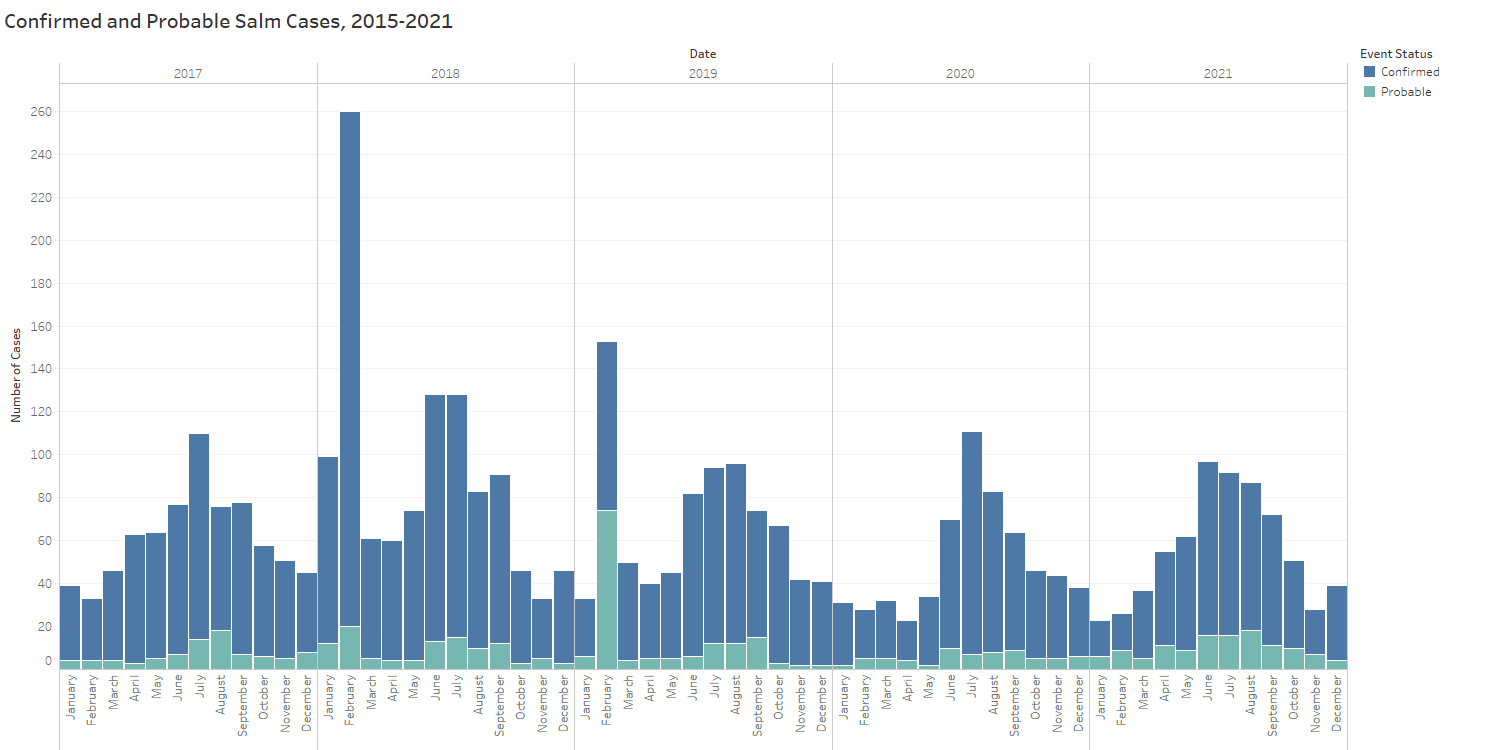Salmonella
Definition
Salmonella infection (Salmonellosis) is a common bacterial disease. Salmonella bacteria live in the gut of animals and humans and can be found in the feces of an infected animal or person.
Salmonella is reportable to the Iowa Department of Public Health by Iowa Administrative Code 641 IAC 1.
Symptoms
There are many kinds of Salmonella bacteria, but only a few cause illnesses in people. Most of the illnesses caused by Salmonella are grouped as gastroenteritis (or sometimes incorrectly referred to as “stomach flu”).
Usually, people who get salmonellosis develop symptoms within 12-36 hours but can experience symptoms as early as 6 hours to as late as 3 days after ingestion of the bacteria.
Signs and symptoms of Salmonella infection generally last 4-7 days. Most people get better without treatment. In some cases, the diarrhea associated with a Salmonella infection can be dangerously dehydrating. In that event, see a doctor immediately.
Signs and symptoms may include:
- Diarrhea
- Headache
- Fever
- Nausea
- Abdominal pain
- Dehydration
- Vomiting
- Muscle pains
- Bloody stools
Typhoid fever is a more severe disease caused by Salmonella.
Causes
Salmonella bacteria live in the intestines of people and animals, including birds. Most people are infected with Salmonella by eating foods that have been contaminated by feces. Commonly infected foods include:
- Beef
- Poultry
- Milk
- Eggs
- Fruits and vegetables
Foods can become contaminated when handled by people who do not wash their hands with soap and water after using the bathroom or changing a diaper.
Reptiles, like turtles, lizards and snakes, often carry Salmonella. Many chicks and young birds carry Salmonella in their feces. People should always wash their hands immediately after handling a reptile or bird, even if the animal is healthy. Adults should also assure that children wash their hands after handling a reptile or bird or after touching its environment.
Risk Factors
Factors that may increase your risk of Salmonella infection include activities that bring you into contact with Salmonella bacteria and certain health conditions that weaken your body’s ability to fight the infection.
Exposure
- International Travel. Salmonellosis is one of the most common foodborne diseases. The risk of Salmonella infection increases when traveling to developing countries with poor sanitation.
- Pet birds or reptiles. Many pets, particularly birds and reptiles, can be infected with Salmonella bacteria.
Stomach and bowel disorders
- Antacids. Stomach acid kills many kinds of bacteria including Salmonella. Lowering your stomach’s acidity allows more Salmonella bacteria to survive.
- Inflammatory bowel diseases. This group of disorders damage the lining of the intestines, which makes it easier for Salmonella bacteria to take hold.
- Recent antibiotic use. Antibiotics can reduce the number of “good” bacteria in the intestines, which allows Salmonella to grow.
Immunity problems
- HIV/AIDS
- Sickle cell disease
- Immunosuppressive treatment
Prevention
- Handwashing is important for preventing all illness including Salmonellosis. Always wash your hands carefully with soap and warm water before preparing food, after using the toilet, after handling pets, especially reptiles, and after handling dirty diapers.
- Make sure that infant’s and children’s hands are washed.
- Always refrigerate meats.
- Always cook meats completely. Never eat raw meat.
- Always cook eggs or food containing raw eggs.
- Avoid unpasteurized milk or foods made with unpasteurized milk.
- Wash counter tops, cutting boards, and any utensil after use on raw meat or eggs.
- If making foods such as eggnog, homemade ice cream, or sauces that include raw eggs, use pasteurized eggs. These can be found at grocery stores, in the refrigerated section , as liquid or shell eggs.
Treatment
Salmonellosis usually last 5-7 days and usually do not need treatment other than drinking plenty of fluids. Persons with more severe illness may need rehydration with intravenous (IV) fluids and/or treatment with antibiotics. Always consult your health care provider if you have questions about your health or before starting any treatment.
Statistics
There were 669 cases of salmonellosis in 2021.
For more detailed information and statistics on all notifiable diseases, please see our current annual report located in the reports section of the CADE homepage.

Additional Resources
Public
Public
Schools
Business and Child Care
Health Care Providers